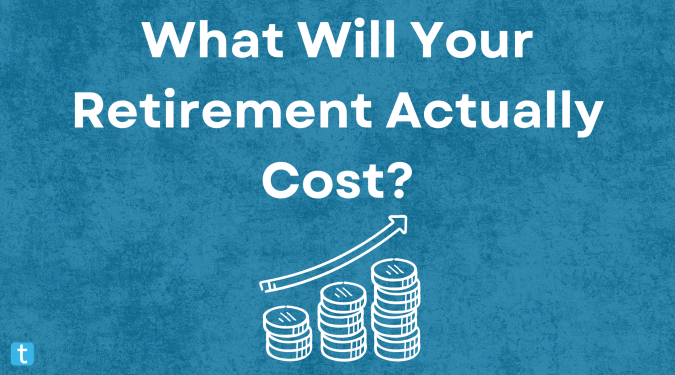My last post centered around starting retirement planning with a vision, not a number.
It’s tempting to jump straight into the math. But before you figure out how much you need to retire, you first need to figure out what you’re retiring to. Once you’ve pictured your ideal retirement and built a framework around that vision (what we call goals), you can begin estimating what it might take to support that life financially.
Let’s walk through the next step together. And as always, we’ll keep things simple.
Step 1: Use Your Vision to Estimate Monthly Spending
You’ve already defined your dream retirement. Maybe it includes travel, volunteering, time with family, or simply more peace and space in your day. Now it’s time to translate that into a rough spending plan.
Start with what you spend now, then adjust:
– Some expenses may drop, like commuting, work clothes, or your mortgage.
– Others may rise, such as healthcare, travel, or hobbies you finally have time for.
– Some may go away completely, including retirement savings contributions or life insurance premiums.
– You may also face unexpected costs, like covering long-term care later in life.
If you read my last post, you’ve already thought through the difference between essential and discretionary expenses. For this step, just bring those categories back to mind and estimate what each might cost. If you’re new here, essentials include housing, food, insurance, and healthcare. Discretionary expenses cover travel, hobbies, gifts, and anything that could be scaled back if needed.
You don’t need perfect numbers. Just a realistic ballpark that reflects the life you actually want.
Step 2: Subtract Your Guaranteed Income (When It Starts)
Once you’ve estimated your spending, the next step is to figure out how much of it will be covered by income sources you can count on.
These typically include:
– Social Security
– Pensions
– Annuities
You may retire before these sources begin. If that’s the case, you’ll draw more heavily from your investment portfolio in the early years. That isn’t necessarily a problem, especially if your overall withdrawal rate is reasonable and you’re comfortable scaling back later when other income sources start.
Here’s a quick example:
– Estimated annual spending: $90,000
– Social Security and pension income (when it begins): $40,000
– Portfolio needs to cover: $50,000 per year, or more in the early years
This step gives you a clearer view of what your investments will need to provide.
Step 3: Estimate the Portfolio You’ll Need
One common planning guideline is the 4% rule. This is not a guarantee or a rigid rule. It’s an observation based on history. The idea is that if you withdraw 4% of your portfolio each year, adjusted for inflation, your money would have lasted through nearly every 30-year retirement period in U.S. history.
That includes some very challenging times like the Great Depression, World War II, and the high inflation era of the 1970s.
Using this as a starting point:
– If your portfolio needs to generate $50,000 per year, you’d aim for about $1.25 million in savings.
But retirement isn’t fixed. Spending changes over time. What matters more than the number is how flexible your lifestyle can be.
If you have a lot of discretionary spending, you can cut back when markets are down. If most of your spending is essential, you may want a lower withdrawal rate for added safety.
The 4% rule gives you a rough target. It is a tool, not a finish line.
Step 4: Are You On Track?
At this point, you’ve built something far more useful than any simple online retirement savings calculator:
– A vision of your ideal retirement
– A rough idea of what it will cost
– An understanding of your income sources
– And an estimate of how much you’ll need to save
Now ask yourself: how close are you?
If you’re already there, congratulations. You’ve reached financial independence.If you’re not there yet, don’t panic. You’ve done the hard part. Now you can start making intentional progress.
Here are a few steps that can help:
– Increase your retirement contributions, especially if you’re over 50 and eligible for catch-up limits.
– Look for ways to reduce expenses or pay off debt before retirement.
– Consider whether working longer is worth it to help you reach the life you’ve envisioned. Even one or two additional years can make a meaningful difference.
Final Thought
This is retirement planning that begins with your life, not someone else’s formula.
By focusing on your own goals, values, and priorities, you’ve taken a major step toward retiring on purpose. Now you have clarity, a general direction, and the flexibility to make adjustments along the way.
You don’t need to chase a perfect number. You just need a plan that supports the life you actually want.
Together Planning is a registered investment advisor. The information presented is for educational purposes only. It should not be considered specific investment advice, does not take into consideration your specific situation, and does not intend to make an offer or solicitation for the sale or purchase of any securities or investment strategies. Together Planning has a reasonable belief that this marketing does not include any false or material misleading information statements or omissions of facts regarding services, investments, or client experiences. Together Planning has a reasonable belief that the content will not cause an untrue or misleading implication regarding the adviser’s services, investments, or client experiences. Be sure to consult with a qualified financial advisor and/or tax professional before implementing any strategy discussed herein.

